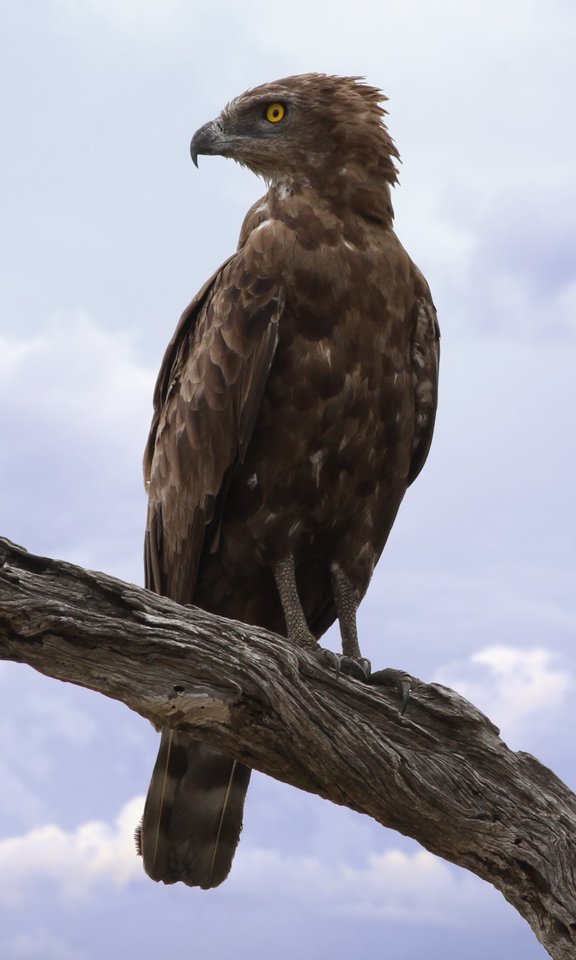Brown Snake Eagles (Circaetus cinereus) are known for their specialized diet, which consists almost entirely of snakes, including venomous ones like cobras and puff adders. They build small nests high in the tops of trees, often in trees with dense foliage for added camouflage. The female lays a single egg and incubates it for approximately 50 days, while the male brings food for both the female and the chick. After hatching, it takes about 100 days for the eaglet to grow strong enough to fly for the first time.
Do Brown Snake Eagles Abandon Their Eggs?
No, there is no clear evidence to suggest that Brown Snake Eagles abandon their eggs. In fact, the available information indicates that the female incubates the egg for around 7 weeks, with the male feeding her at the nest during this time. The hatchling then takes to the wing for the first time when it is about 3 months old. This suggests that Brown Snake Eagles are committed to their offspring and do not abandon their eggs.
Nesting Behavior of Brown Snake Eagles
 Image source: Brown snake eagle By Derek Keats
Image source: Brown snake eagle By Derek Keats
Brown Snake Eagles build small nests high in the tops of trees, often in trees with dense foliage for added camouflage. The female lays a single egg and incubates it for approximately 50 days. During this time, the male brings food for both the female and the chick.
Nest Construction
Brown Snake Eagles construct their nests using sticks, twigs, and other plant material. The nests are typically small, measuring around 60-90 cm in diameter and 30-45 cm in depth. The nests are often built in the tops of tall trees, providing the eagles with a good vantage point to spot their prey.
Egg Laying and Incubation
The female Brown Snake Eagle lays a single egg, which she then incubates for approximately 50 days. During this time, the male brings food to the female, ensuring that she has the energy and resources needed to successfully incubate the egg.
Chick Rearing
After the egg hatches, the chick remains in the nest for around 100 days before it is strong enough to take its first flight. Both the male and female Brown Snake Eagles are involved in feeding and caring for the chick during this time.
Diet and Hunting Behavior of Brown Snake Eagles
As their name suggests, Brown Snake Eagles are specialized predators of snakes, including venomous species such as cobras and puff adders. They use their keen eyesight and powerful talons to capture their prey.
Prey Preferences
Brown Snake Eagles primarily feed on snakes, but they may also occasionally consume other small vertebrates such as lizards, small mammals, and birds. They are particularly adept at hunting venomous snakes, which make up a significant portion of their diet.
Hunting Techniques
Brown Snake Eagles use a variety of hunting techniques to capture their prey. They may soar high above the ground, scanning the landscape for movement, or they may perch in a tree and wait patiently for a snake to appear. When they spot their prey, they swoop down and use their sharp talons to grasp the snake, often killing it with a powerful strike to the head.
Conservation Status and Threats
The Brown Snake Eagle is classified as Least Concern on the IUCN Red List of Threatened Species. However, like many other raptor species, they face a variety of threats that can impact their populations.
Habitat Loss and Degradation
One of the primary threats to Brown Snake Eagles is the loss and degradation of their natural habitats. Deforestation, urbanization, and agricultural expansion can all lead to the destruction of the tall trees and dense foliage that these eagles rely on for nesting and hunting.
Persecution and Poisoning
In some regions, Brown Snake Eagles may be persecuted by humans who view them as a threat to livestock or other animals. Additionally, the use of pesticides and other toxins can lead to the poisoning of these birds, either directly or through the consumption of contaminated prey.
Conservation Efforts
While the Brown Snake Eagle is not currently considered to be at high risk of extinction, conservation efforts are still important to ensure the long-term survival of this species. These efforts may include habitat protection, education and awareness campaigns, and monitoring of populations to identify and address any emerging threats.
Conclusion
In conclusion, the available evidence suggests that Brown Snake Eagles do not abandon their eggs. These specialized predators are committed to their offspring, with the female incubating the egg for around 7 weeks and both parents caring for the chick until it is strong enough to fly. While they face some threats, such as habitat loss and persecution, the Brown Snake Eagle is currently classified as Least Concern on the IUCN Red List, indicating that their populations are relatively stable.
References:
- Global Raptor Information Network. 2021. Species account: Brown Snake Eagle Circaetus cinereus. Downloaded from http://www.globalraptors.org on 16 Aug. 2021
- Oiseaux-Birds. Brown Snake Eagle – Circaetus cinereus. https://www.oiseaux-birds.com/card-brown-snake-eagle.html
- DeWetsWild. 2020-04-05. Brown Snake Eagle. https://dewetswild.com/2020/04/05/brown-snake-eagle/.

